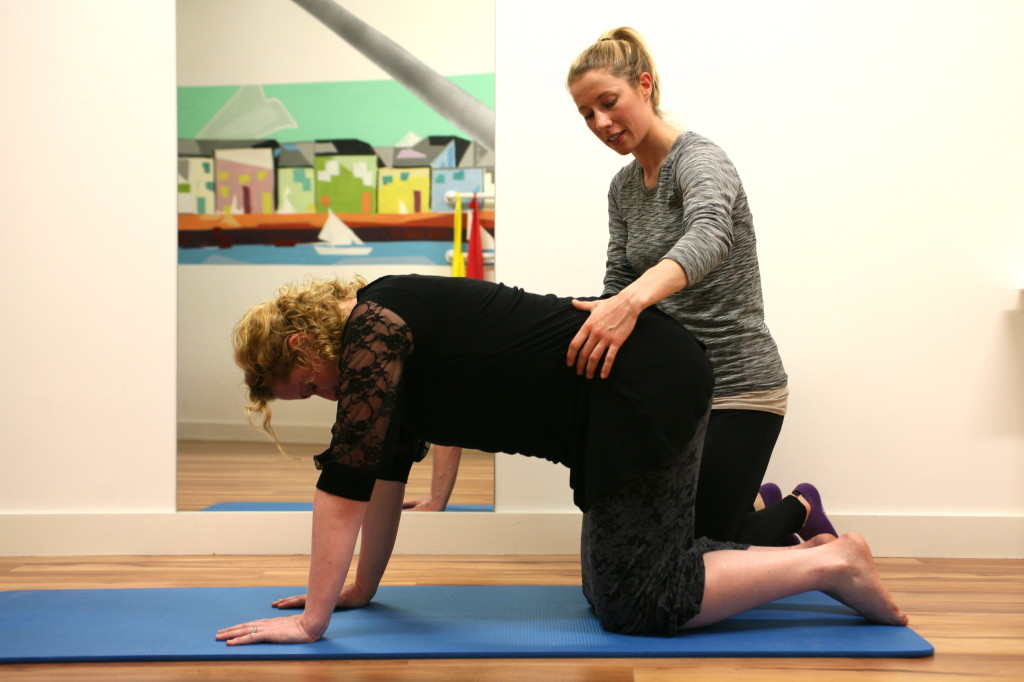Tummy gap after having a baby
What is a DRAM?
A DRAM (Diastasis of the Rectus Abdominus Muscle) is an abnormal separation of right and left rectus abdominus muscle. So it is the ‘tummy gap’ that we speak of, often with regard to pregnancy and after having a baby.
A certain amount of separation is common during pregnancy as it allows room for the growing baby.
What factors increase the likelihood of getting a diastasis / tummy gap?
Multiple pregnancies
Large babies
Increased weight of mother
Poor collagen make-up of skin
Chronic constipation
Lots of heavy lifting
What can I do to help my DRAM / tummy gap to heal?
We need to build from the inside out. Exercises should focus on good posture, correct breathing, low tummy and pelvic floor contraction.
Exercises for the first 6-8 weeks after having your baby:
At Evidence-Based Therapy Centre, Chartered Physiotherapist specialising in Women’s Health, – Julianne Woodcock – will teach you appropriate exercises to help such as:
– Low Tummy Exercise (Transversus Abdominus)
– Pelvic Tilting
– Pelvic Floor Exercises
During and after pregnancy we want to avoid as much as possible doming or bulging forwards of the abdominal muscles – this may be noted with activities such as lifting, standing up or getting out of bed.
We need to get our solid foundations first, before looking to our outer muscles. We are looking to work our pelvic floor muscles and low tummy muscles (clinical pilates exercises). In this way we are building inner strength so as to generate tension across our diastasis. By doing global, external muscle exercises like sit ups, we may actually be drawing the rectus abdominal muscles away from each other, thereby actually further increasing our DRAM. We need to look at the whole picture. Breathing correctly, maintaining good posture, having adequate core strength, good lifting technique – all these things are so important in the DRAM story.
Tips for getting out of bed
If we sit straight up from a lying position, we are at risk of this bulging or doming of the abdomen. Instead, aim to roll over onto your side first.
– Engage lower tummy muscles and pelvic floor, roll over onto your side, grip the edge of the bed, drop your legs down over the side of the bed, gently push yourself up into a seated position using your elbow and hands. Breathe throughout this movement.
Tips for emptying your bowel
Key tip while emptying your bowel is to breathe throughout. If you hold your breath and push, you are putting a large amount of pressure down onto your pelvic floor and pressure out to your diastasis.
Sit with both feet flat on the floor, lean forwards. Lean your forearms on your thighs or cross your hands across your lower tummy giving gentle support to your abdomen. Try to avoid straining if possible as this will increase the pressure on the diastasis.
Tips for lifting
Lifting can be a difficulty especially if you have a toddler. Lifting with poor technique can further increase your diastasis along with putting strain on your pelvic floor. If you need to lift something – perform a ‘knack’ – which is a pelvic floor squeeze before you lift. Engage lower tummy muscles, and breathe out as you lift. This will help avoid undue downward pressure on your pelvic floor and will help avoid increasing your diastasis.
Tips on posture
Having good posture is important so as to limit the pressures put on your back. Also having good posture ensures tummy muscles are supporting your middle.
Sitting: Sit with your bum right back in the chair and your back fully supported. If sitting unsupported, slouching will stop your tummy muscles working, and sitting very tall will cause strain on your low back. Aim to sit half way between these two positions, in an upright but comfortable position.
Standing: Stand up tall, imagine your head is a helium balloon! Gently draw in your lower tummy muscles to give you a ‘strong position’. This is particularly important when you are holding and carrying your baby.
Tips on return to exercise after having a baby
A Chartered physiotherapist can teach you exercises to help ensure a safe return to exercise. Going for gentle walks if you are comfortable to do so can also be helpful.
It is advisable to consult a Women’s Health Physiotherapist:
When progressing to higher level exercises
If there is doming of your abdominal muscles when exercising
If exercise causes discomfort
If you still have a tummy gap 8 week after having your baby
To book an appointment for Women’s Health Physiotherapy
If you would like to address your diastasis you can all Evidence-Based Therapy Centre today on 091 727777 and make an appointment to see our Women’s Health Physiotherapist – Sylvia Farrell. You can also get in touch via the contact page.
She will carry out an individual assessment and set you on the road to recovery. Ante and Post-Natal Clinical Pilates Classes are also a great way of complementing your rehabilitation.




